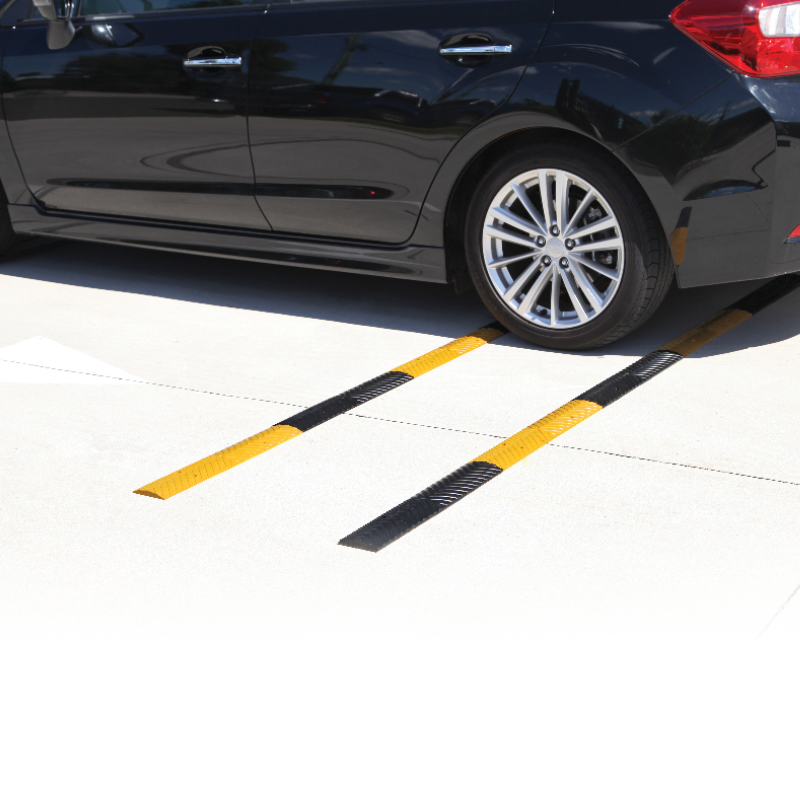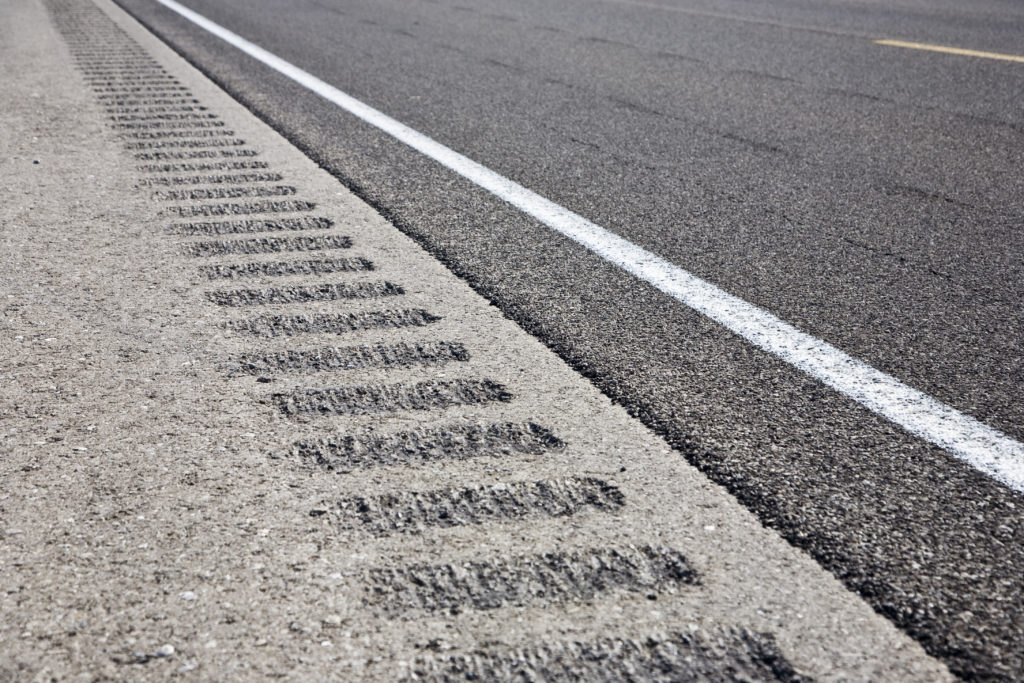If you've ever driven on highways or roads with rumble strips, you might have wondered about their impact on your vehicle. Are these grooved surfaces meant to keep us safe actually harming our tires? In this post, we'll explore the purpose of rumble strips and if they truly damage your tires or vehicle. Buckle up; let's dive in!
What Are Rumble Strips?

Rumble strips are those distinct, rhythmic grooves or raised patterns found on the shoulders and centerlines of many roads. They serve a crucial purpose: to alert drivers when they begin to drift out of their lane or off the road. You can probably picture it—you're cruising down the highway, and suddenly your tires hit those rumble strips, creating a loud, vibrating sensation that snaps you back to attention. But what exactly are these strips made of, and how do they work?
Here’s a closer look:
- Design: Rumble strips can be either ground-in or molded. Ground-in strips are cut into the pavement, while molded strips are added on top. Both types help produce sound and vibration when a vehicle rolls over them.
- Location: You’ll typically find rumble strips on the sides of the road, where they function as a warning system, or between lanes to prevent head-on collisions. They’re often placed strategically where accidents could occur, such as near exits or high-traffic areas.
- Sound & Vibration: The primary purpose of rumble strips is to create noise and tactile feedback. This alerts drivers who might be distracted or drowsy, prompting them to adjust their driving to stay safe.
Rumble strips are typically made from materials that can withstand harsh weather and heavy loads. They are designed to last, meaning they won't degrade easily, which is great for maintenance budgets but raises questions for drivers about potential tire damage.
Now, you might be wondering if the repetitive bump of the strips causes any real harm to your tires or vehicle. While the groove patterns do create friction, they are not designed to puncture or tear your tires. Most vehicles can handle driving over rumble strips without any adverse effects. However, the experience can be jarring, particularly at higher speeds.
It’s essential to pay attention when driving over rumble strips. Here are a few tips to minimize any potential wear on your tires:
- Reduce Speed: If you know you're approaching rumble strips, easing off the accelerator can help mitigate the impact.
- Stay Centered: Attempt to stay centered in your lane to avoid driving over them unnecessarily.
- Check Tire Pressure: Ensuring that your tires are properly inflated can help maintain their integrity when driving over rough surfaces.
Overall, while rumble strips are a safety feature designed to keep drivers alert, it's wise to remain aware of how you interact with them. In the next sections, we’ll dive deeper into the impacts of rumble strips on your tires, vehicle health, and what you can do to protect your ride while benefiting from the safety they provide.
Also Read This: Can You Feel the Rumble? Exploring the Science Behind the Phenomenon
3. How Rumble Strips Work for Road Safety

Have you ever been driving along the highway, only to feel a sudden jolt as your vehicle traverses a rumble strip? These slightly raised strips of asphalt or concrete may seem like minor bumps, but they play a crucial role in road safety. Their main purpose? To alert drivers when they're drifting off the roadway, often serving as a wake-up call during monotonous stretches of driving.
Rumble strips are designed to create a tactile and auditory warning when a vehicle runs over them. The sound produced is quite distinct, often likened to a series of loud rumbles or vibrations. This serves multiple purposes:
- Increased Awareness: The vibrations and noise draw the driver's attention back to the road, reminding them to stay centered.
- Reduced Accidents: By alerting fatigued or distracted drivers, these strips significantly reduce the likelihood of unintentional lane departures, which can lead to serious accidents.
- Versatile Placement: Rumble strips can be strategically placed before sharp turns, curves, or near exits, ensuring drivers are informed of potential dangers ahead.
Interestingly, there are two main types of rumble strips:
- Shoulder Rumble Strips: Located on the sides of the roads, these are meant to alert drivers who veer off the path.
- Centerline Rumble Strips: Found along the center of a divided road, these help prevent head-on collisions by warning drivers who might drift into oncoming traffic.
Overall, the primary goal of rumble strips is prevention. By ensuring that drivers remain attentive and alert, these strips have been proven to decrease accident rates in many regions. While they may be a bit jarring when you encounter them, their benefits to road safety are undeniable. So, the next time you feel that rumble, remember it’s there for your safety!
Also Read This: How to Play Rumble Roses and Unlock All Characters
4. Effects of Rumble Strips on Tires

Now that we’ve explored the impressive safety benefits of rumble strips, let’s dive into a question that many drivers ponder: do rumble strips have any negative effects on tires?
While the primary purpose of rumble strips is to enhance safety, their design does lead to some unique interactions with your vehicle’s tires. Here’s what you need to know:
- Increased Wear: Frequently driving over rumble strips can cause increased wear on your tires. The sudden jolts and vibrations can lead to uneven tread wear, which over time might necessitate more frequent tire replacements.
- Punctures and Damage: Although modern tires are built to endure a fair amount of abuse, the rough texture of rumble strips could potentially lead to minor punctures or damage, particularly if your tires are older or already worn.
- Alignment Issues: Regularly hitting rumble strips can also affect your vehicle's alignment. If your suspension and steering mechanics are being jolted consistently, it might lead to misalignment, which can further impact tire wear and handling.
However, it’s essential to keep the effects of rumble strips in perspective. For most drivers, the benefits of improved safety far outweigh the potential risks to tire longevity. Regular maintenance and inspections of your tires can help mitigate any potential damage.
If you find yourself frequently driving on roads with rumble strips, here are some tips to minimize the impact on your tires:
- Maintain Proper Tire Pressure: Ensuring your tires are always properly inflated can help them absorb shocks better.
- Inspect Your Tires Regularly: Look for any signs of tread wear or damage and address any issues promptly.
- Drive Smoothly: Avoid sudden swerves or hard turns when approaching a rumble strip, which can reduce the impact on your tires.
In conclusion, while there are some effects of rumble strips on tires, they are generally minimal compared to the significant safety benefits they provide. A bit of maintenance and mindful driving goes a long way to ensure that both you and your vehicle stay safe on the road!
Also Read This: How to Become a Rumble Instructor and Start Your Career in Fitness
5. Factors That Influence Tire Damage from Rumble Strips
When it comes to the relationship between rumble strips and tire damage, several factors come into play. Understanding these factors can help you take better care of your tires while driving on roads equipped with rumble strips. Let’s dive into some of the key considerations:
- Speed: The faster you drive over rumble strips, the greater the potential for tire damage. At higher speeds, the sudden jolt can strike the tire’s sidewall more forcefully, leading to wear and tear or even blowouts.
- Tire Condition: Worn-out tires, especially those with low tread depth or sidewall damage, are more susceptible to damage from rumble strips. Regularly inspecting your tires can help ensure they’re in good condition when you encounter these road features.
- Type of Rumble Strips: Not all rumble strips are created equal. Some are made from more forgiving materials than others. For example, asphalt rumble strips may produce a softer impact compared to harsher concrete varieties. It's essential to be aware of the type of rumble strips you may encounter in your travels.
- Vehicle Weight: Heavier vehicles exert more pressure on tires. This means that a large SUV or truck hitting rumble strips can potentially incur more damage than a lighter sedan, especially if the tires are not well-maintained.
- Alignment and Suspension: A vehicle’s alignment and overall suspension system play a significant role in how it absorbs shocks. If your vehicle's alignment is off or the suspension is faulty, you might feel more impact from the rumble strips, leading to increased chances of tire damage.
Understanding these factors helps you make informed choices about when and how fast to drive over rumble strips. The goal is to avoid unnecessary damage while still ensuring road safety!
Also Read This: What Channel Is WWE Royal Rumble On
6. Vehicle Design and Rumble Strips
Vehicle design is a critical element in how a car interacts with rumble strips. This includes the type of tires, overall vehicle weight, and suspension system. Let’s take a closer look at how these design components influence the impact of rumble strips on your vehicle:
- Tire Design: Tires come in various designs and rubber compounds, each offering different levels of durability and flexibility. Performance tires, for instance, tend to have a stiffer sidewall, which may transmit more impact force to the tire when hitting rumble strips. In contrast, all-season tires are engineered for a balance of comfort and durability, potentially absorbing some bumps better.
- Wheelbase and Suspension: The wheelbase of a vehicle, which is the distance between the front and rear axles, plays a role in how shocks are absorbed. A longer wheelbase can provide a smoother ride over uneven surfaces, including rumble strips. Additionally, advanced suspension systems incorporate technology to better handle impacts, which can reduce the chances of tire damage.
- Vehicle Height: The height of a vehicle can also influence its interaction with rumble strips. Higher vehicles, like SUVs, may experience different impacts compared to lower cars. For example, an SUV might 'bounce' slightly off the rumble strips, while a sedan may feel a sharper jolt.
- Load and Cargo: The actual load in your vehicle can alter how it handles bumps and strips. A fully loaded vehicle may experience more significant impact, increasing the likelihood of tire issues, whereas a lighter, more empty load may lead to a smoother experience.
Ultimately, understanding your vehicle’s design can help you navigate the road more safely. Whether you’re driving a compact car or a heavy truck, being aware of how your vehicle interacts with rumble strips is essential for maintaining overall tire health and vehicle safety.
Also Read This: What Makes Your Belly Rumble and What Does It Mean
7. Case Studies and Research Findings
When it comes to road safety, the installation of rumble strips has been a game changer. They serve as auditory and tactile alerts for drivers, typically placed along highways and intersections to reduce accidents caused by drowsy or distracted driving. But how do they affect our vehicles, especially our tires? Some intriguing case studies and research findings shed light on this topic.
One notable study conducted by the American Traffic Safety Services Association (ATSSA) examined the impact of rumble strips on both driver behavior and vehicle performance. Researchers found that while most vehicles experienced minimal damage from occasional encounters with rumble strips, certain driving patterns, such as excessive speeding or aggressive lane changes, could exacerbate potential tire wear.
Another research project involving real-world data collected from highway patrol reports indicated that vehicles frequently traversing rumble strips did not report a significant increase in tire-related incidents. This suggests that while the structure of rumble strips can create a jolting experience, they don't inherently lead to more tire blowouts or damage.
However, it's essential to note that the tire wear observed in some cases could be attributed not solely to the rumble strips themselves but also to driving habits and environmental conditions. For example, tires that were already worn or under-inflated were more likely to experience damage when encountering the vibrations of rumble strips at high speeds.
- Study 1: ATSSA's investigation - minimal effects on tire wear in most conditions.
- Study 2: Highway patrol reports - low incidence of tire damage linked to rumble strips.
- Key takeaway: Aggressive driving increases risks during rumble strip encounters.
Overall, while rumble strips are useful safety features, drivers should remain aware of their vehicle's condition and adopt safe driving practices to mitigate potential damage. The emphasis should not only be on the road itself but also on how we drive over it.
Also Read This: How to Play My Hero Academia Ultra Rumble and Dominate the Arena
8. Preventing Tire Damage While Driving Over Rumble Strips
So, how can you prevent tire damage while navigating rumble strips? It’s a serious concern for many drivers, and thankfully, there are several practical strategies you can employ to minimize risks. Here are some effective tips to ensure your tires—and your vehicle overall—stay in great shape.
- Maintain Proper Tire Pressure: Always check your tire pressure regularly. Under-inflated tires can become more susceptible to damage when hitting rumble strips. Aim for the manufacturer's recommended PSI, which can usually be found in your owner’s manual or on a sticker inside your driver's door.
- Inspect Your Tires: Before embarking on a long journey, it's a good idea to inspect your tires for any signs of wear and tear. Look for uneven tread wear, which could signal alignment issues, and ensure there are no bulges or cracks.
- Avoid Excessive Speed: Slow down while approaching rumble strips. This not only enhances your safety but also helps to reduce the impact your tires experience. Be mindful of the posted speed limits and road conditions.
- Steering Control: Keep your hands firmly on the steering wheel when driving over rumble strips. This helps you maintain control and reduces the chances of swerving, which could lead to further tire damage.
- Regular Alignment Checks: Ensure your vehicle's wheels are properly aligned. Regularly scheduled alignments reduce uneven tire wear and help maintain optimal handling.
Following these simple tips can significantly decrease the chances of tire damage when driving over rumble strips. Remember, while these safety features are designed to protect your life, your vehicle still deserves some care and attention to ensure it runs smoothly. Happy driving!
Conclusion: Weighing the Risks and Benefits of Rumble Strips
Rumble strips, while designed to enhance road safety, often raise concerns among drivers regarding potential damage to their vehicles and tires. To effectively weigh the risks and benefits, it's essential to consider several factors:
Benefits of Rumble Strips:
- Accident Prevention: Rumble strips alert drowsy or distracted drivers, reducing the likelihood of accidents.
- Increased Visibility: The noise and vibrations from these strips serve as crucial reminders for drivers to remain attentive, especially on highways and in construction zones.
- Cost-Effective Safety Measure: Installing rumble strips is relatively inexpensive compared to the costs associated with accidents and injuries.
Potential Risks:
- Tire Wear: Frequent encounters with rumble strips can lead to increased tire wear over time, particularly if vehicles navigate them at higher speeds.
- Vehicle Stability: Sudden jolts from hitting rumble strips can disrupt vehicle stability, potentially causing loss of control in adverse conditions.
- Noise: The loud sound generated can be uncomfortable for drivers and passengers, especially on long journeys.
In conclusion, while rumble strips are a valuable tool for enhancing road safety, drivers must remain aware of the potential for minor vehicle wear. Regular maintenance and mindful driving can mitigate most negative impacts, making the benefits of safety outweigh the concerns of damage for the majority of vehicles on the road.
 admin
admin








